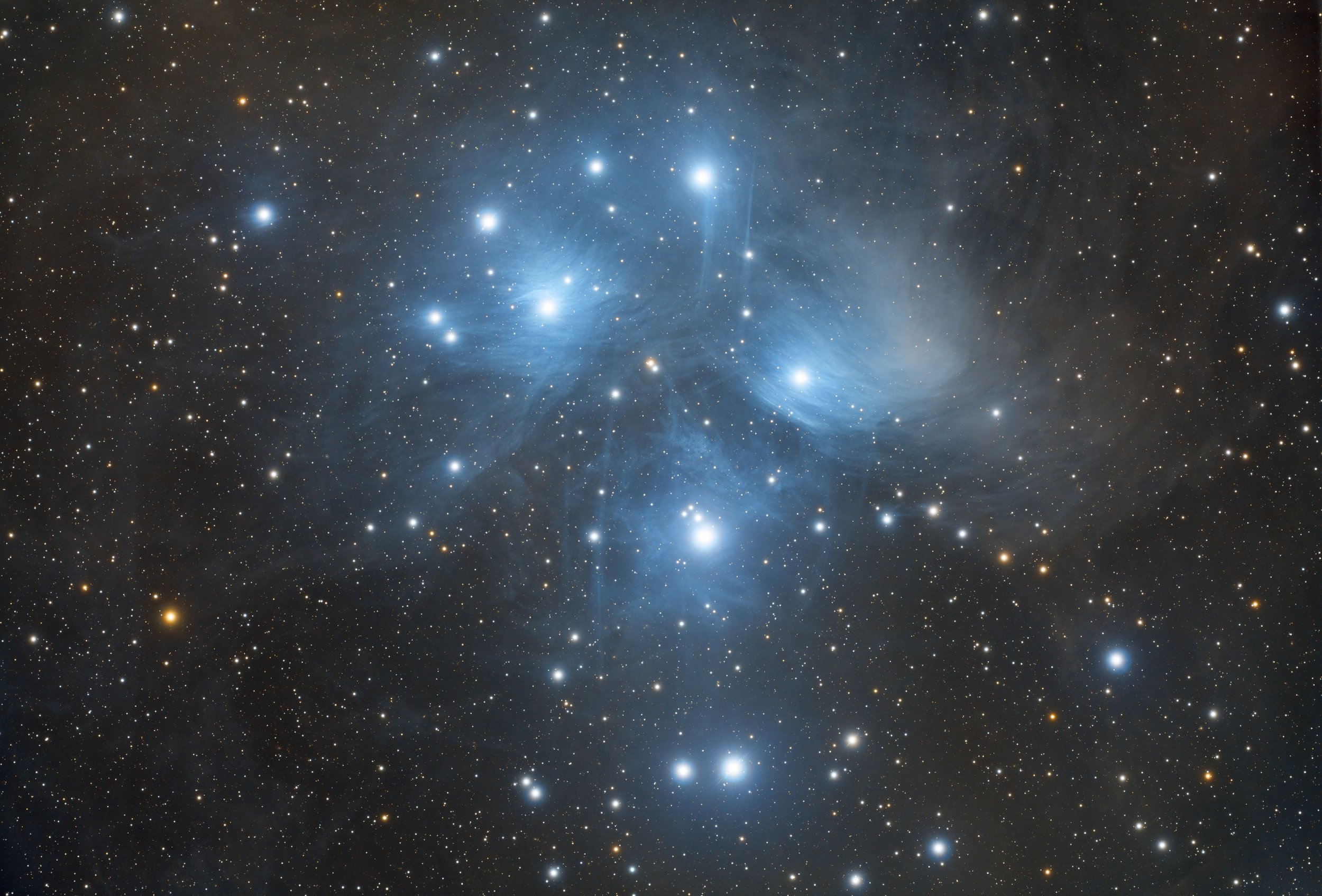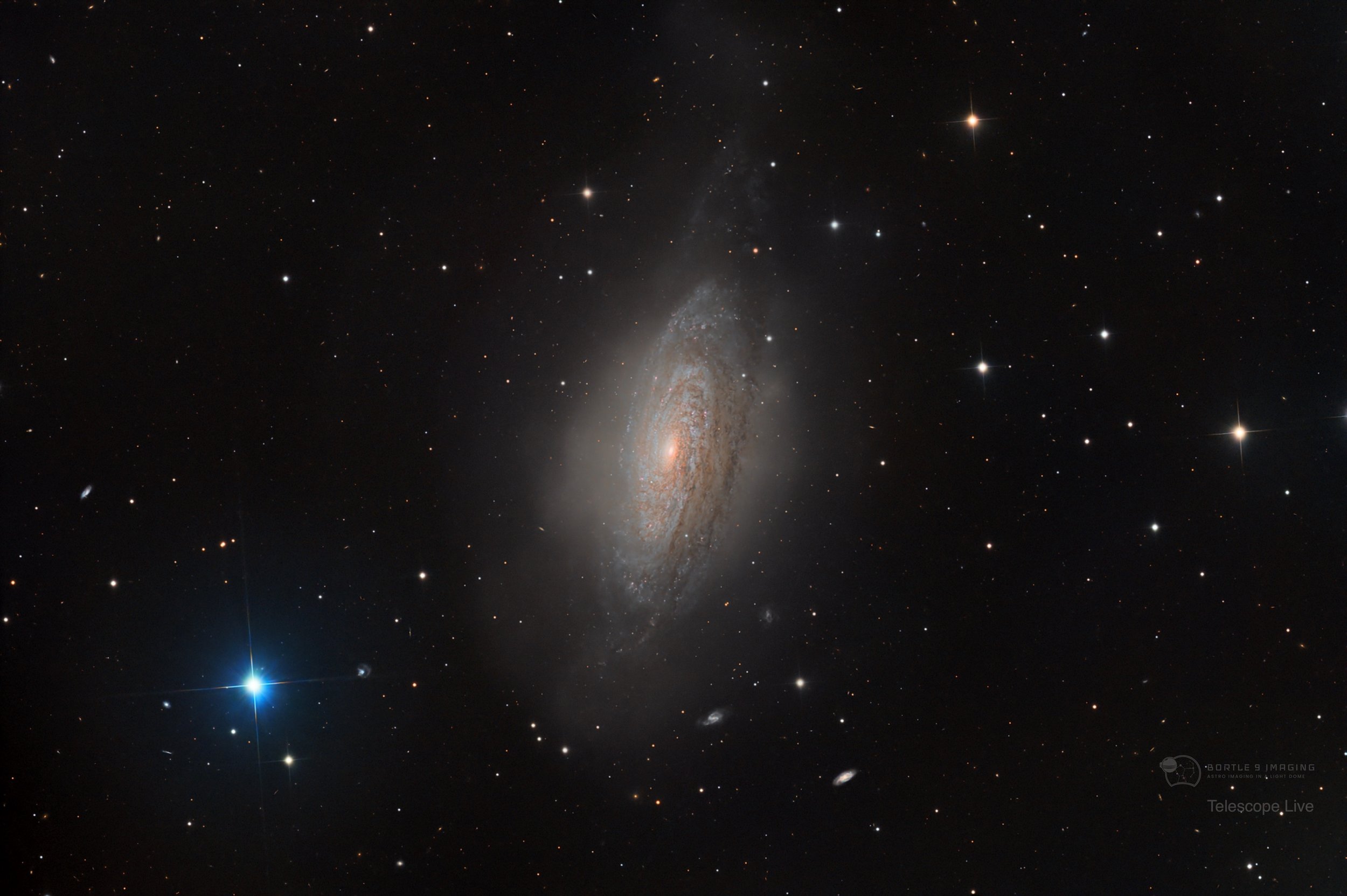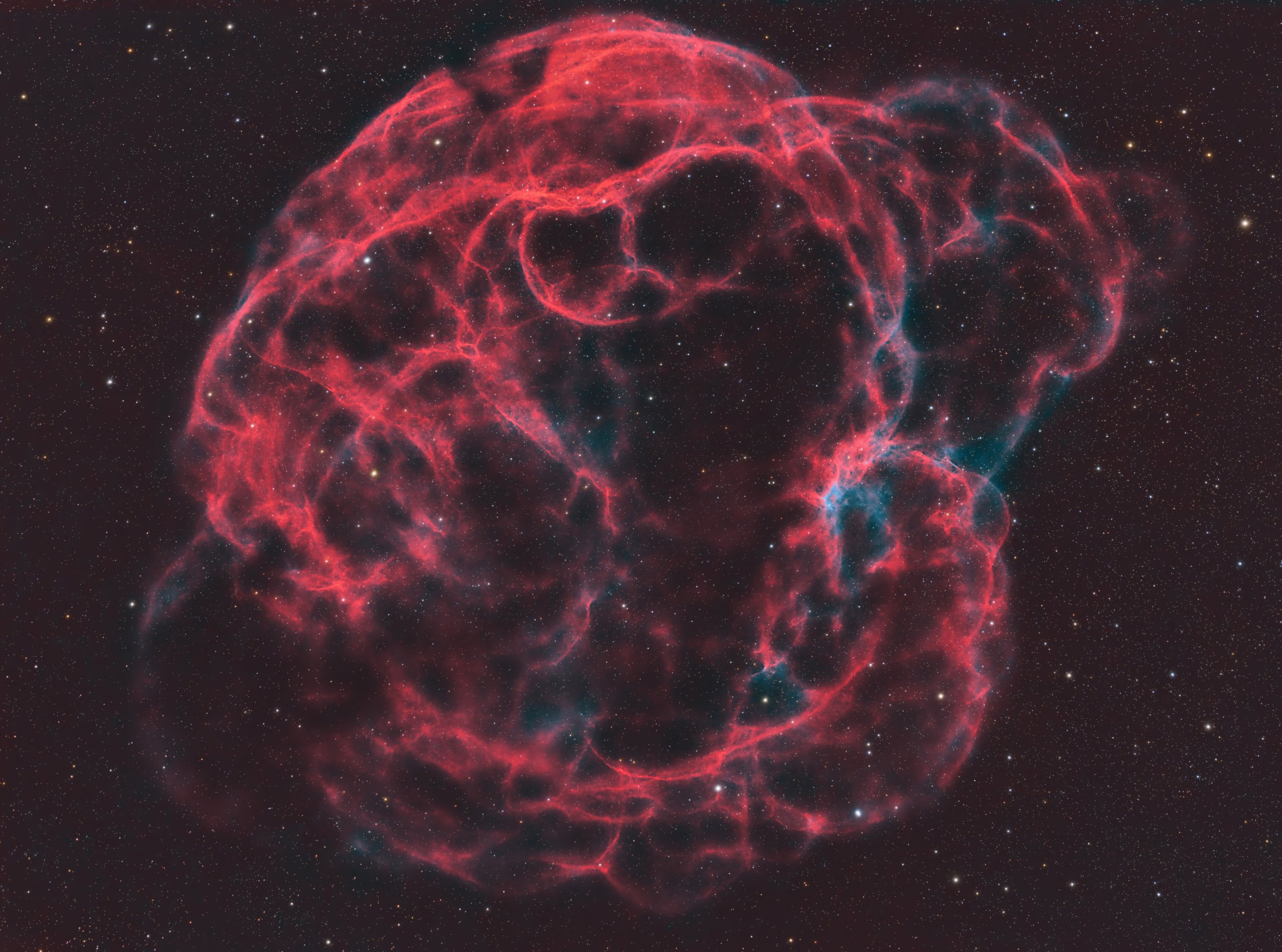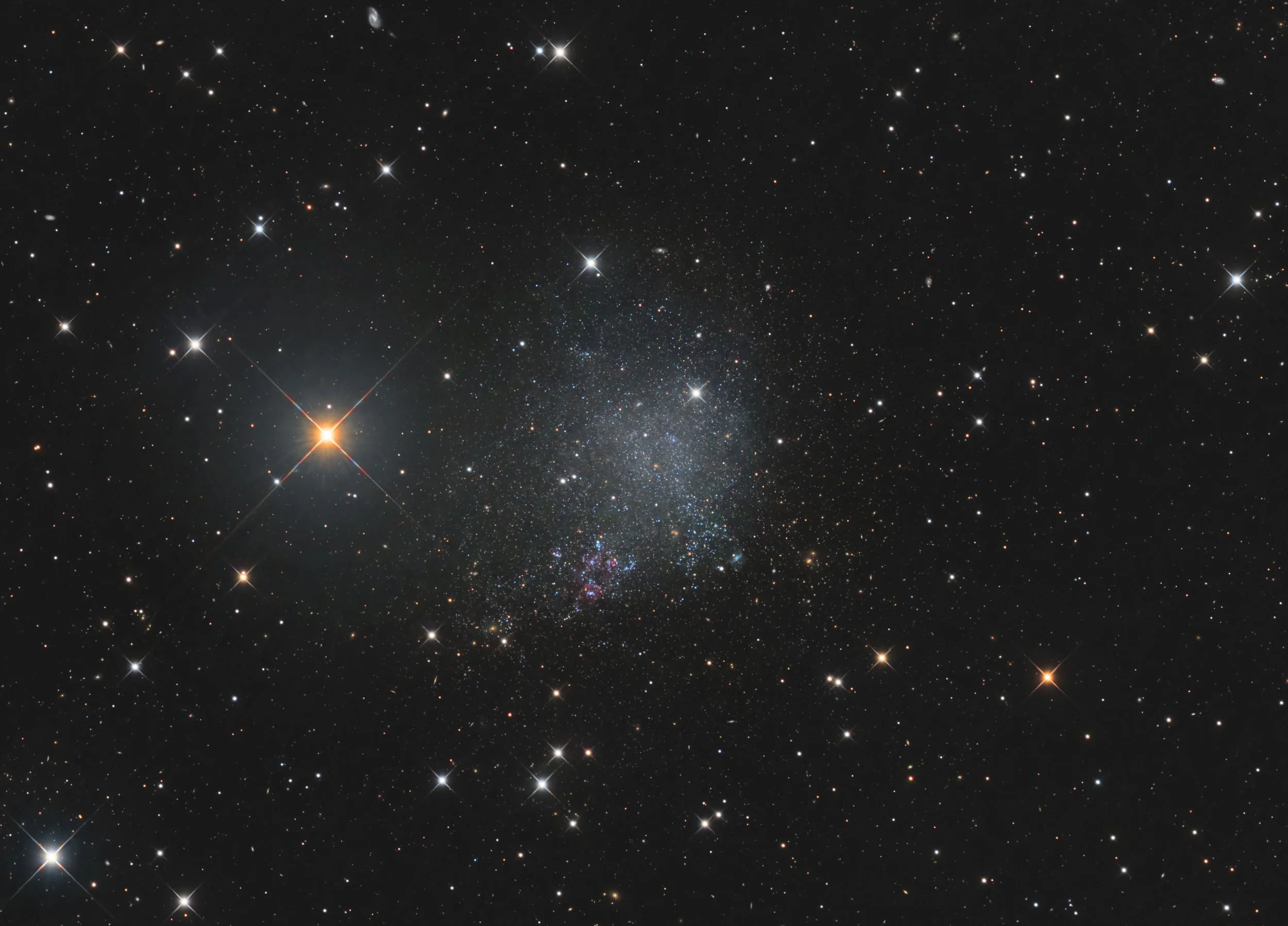
AAPOD2 Image Archives
Alpha Persei Cluster
Within the celestial embrace of the Perseus constellation resides the Alpha Persei Cluster, a captivating open star cluster also known as the Perseus OB1 Association. Comprising a dazzling array of hot, luminous stars, this stellar ensemble serves as a celestial laboratory, offering astronomers valuable insights into the intricacies of star formation and the shared evolutionary trajectories of its brilliant members. Mirfak, the prominent Alpha Persei, commands attention as a radiant centerpiece, illuminating the surrounding stellar companions and contributing to the dynamic stellar tapestry that defines this cosmic gathering.
The Alpha Persei Cluster, with its diverse stellar population, invites observers to delve into the scientific nuances of its composition, revealing a harmonious interplay of varying star sizes and temperatures. This celestial dance, captured within the 2-panel mosaic, not only enchants the eye but also beckons the curious mind to explore the astrophysical intricacies embedded in the heart of Perseus. As astronomers and stargazers alike navigate the cosmic expanse, the Alpha Persei Cluster stands as a testament to the cosmic artistry and scientific fascination inherent in the study of open star clusters.
Standoff at the Border - Good Ghost, Bad Ghost - Two-Panel Mosaic
In the vast expanse of the night sky, a captivating 2-panel mosaic unveils the cosmic dialogue between LDN 1622, colloquially known as the Boogeyman Nebula, and the renowned Messier 78. On the left, the Boogeyman Nebula, a dark molecular cloud, draws the eye into the cosmic shadows where new stars quietly emerge, hidden from direct view but leaving an indelible mark on the celestial tapestry. The enigmatic interplay of light and shadow within LDN 1622 paints a cosmic portrait, enticing observers to explore the mysteries of stellar birth within its inky depths.
On the right, Messier 78 takes center stage—a reflection nebula illuminated by the borrowed radiance of nearby stars. Bathed in the scattered light of these celestial beacons, Messier 78 casts a luminous glow against the cosmic canvas. This celestial dance between darkness and brilliance, portrayed in the 2-panel mosaic, captures the essence of LDN 1622 and Messier 78, offering both a visual feast and an opportunity for scientific contemplation. As the observer navigates this cosmic juxtaposition, they are invited to appreciate the artistry of amateur astrophotography while delving into the scientific nuances that make these celestial entities captivating subjects in the realm of the night sky.
NGC 3521
NGC 3521, a captivating spiral galaxy residing some 26 million light-years away in Leo, showcases a mature spiral structure characterized by pronounced arms adorned with intricate dust lanes, a testament to the galaxy's advanced evolutionary stage. Notably, NGC 3521 stands out for its relatively low rate of star formation compared to peers, prompting astronomers to delve into the environmental and internal factors shaping its stellar populations.
At the heart of NGC 3521 lies a dense central bulge, a congregation of aging stars that bears witness to the galaxy's extensive cosmic journey. This feature offers a glimpse into the galactic spheroid's rich history and the complex interplay of astrophysical forces governing its stellar dynamics. As astronomers unravel the mysteries within NGC 3521, they navigate a scientific frontier, exploring the unique characteristics that define this spiral marvel and shedding light on the diverse pathways of galactic evolution in the cosmic tapestry.
Barnard 150
Bernard 150, nestled within the expansive cosmic tapestry, stands as a testament to the dynamic processes shaping our galactic neighborhood. This astronomical structure, intricately detailed in this image, reveals a symphony of interstellar elements at play, including ionized gases, dark dust lanes, and the luminous glow of newborn stars.
The complexity of Bernard 150 extends beyond its visual appearance, as astronomers delve into the scientific intricacies of its formation and evolution. Stellar winds, radiation pressure, and gravitational interactions contribute to the ever-changing dynamics within the nebula, creating a celestial ballet that unfolds over cosmic timescales.
Cheshire Cat (gravitational lens)
The Cheshire Cat Gravitational Lens is a result of a cosmic dance between massive objects, where the gravitational pull of a foreground galaxy acts as a cosmic magnifying glass, bending and distorting the light from a more distant galaxy located behind it. This gravitational lensing phenomenon creates a captivating optical illusion reminiscent of the elusive grin of the Cheshire Cat.
The Cheshire Cat Gravitational Lens introduces observers to the concept of gravitational lensing—a gravitational phenomenon predicted by Einstein's theory of general relativity. This celestial cat's grin serves as a visual reminder of the profound influence of gravity on the paths that light takes through the vast expanse of space.
Dolphin Head Nebula (Sh2-308) : A Morocco-Chile connection
Sh2-308 emerges as a stellar nursery, where a symphony of ionized gas and dust paints a celestial portrait against the backdrop of Aquila's cosmic expanse. The nebula's intriguing moniker, the Dolphin Head Nebula, stems from its distinct shape, which bears a resemblance to the playful form of a leaping dolphin against the canvas of the night sky.
The Dolphin Head Nebula comes to life through the brilliance of newborn stars illuminating the surrounding interstellar medium. The interplay of light and shadow within the nebula's intricate structure weaves a tale of stellar birth and the ongoing dance of cosmic forces.
Situated approximately 5,000 light-years away, Sh2-308 stands as a testament to the vast and dynamic nature of our galactic neighborhood. As observers gaze upon this celestial dolphin, they are reminded of the boundless creativity at play in the cosmos, where nature's artistry manifests in the intricate details of a nebular realm.
Capella
Capella, the sixth brightest star in the northern hemisphere, takes center stage in this celestial display. The Akira Fuji Effect, a natural occurrence resulting from the star's inherent brilliance and the hazy crystals in the atmosphere, bathes Capella in a radiant aura that sets it apart from both background and foreground stars. This ethereal glow adds a touch of cosmic poetry to the star's luminous presence.
The rapid temperature drop plays a pivotal role in creating the haze of crystals, forming a delicate celestial tapestry that emphasizes Capella's brilliance. As one of the most prominent stars in Earth's night sky, Capella captivates observers with its celestial radiance and unique atmospheric halo, a celestial dance between starlight and the elements.
IC 2220 Toby Jug Nebula
C 2220's origin lies in the expelled cloud of gas and dust emanating from the red giant star HD 65750, nestled within the heart of the nebula. As the expelled material interacts with starlight, it creates a mesmerizing display of bi-conical structures that form the distinctive shape resembling an old English drinking vessel known as a Toby Jug.
Named by three discerning British astronomers, the Toby Jug Nebula stands out among its celestial counterparts for its unique hue. Unlike most reflection nebulae, IC 2220 dons a warm orange color, adding a touch of cosmic elegance to its whimsical appearance.
Spaghetti Nebula
Sh2-240, the Spaghetti Nebula, unfolds within the constellation Taurus, offering a celestial spectacle that defies earthly comparisons. This intricate emission nebula, illuminated by the energetic radiation of newborn stars, reveals delicate filaments resembling strands of celestial spaghetti, hence its evocative name.
In this cosmic kitchen, the Spaghetti Nebula serves as a testament to the dynamic interplay between stars and the interstellar medium. The tendrils of ionized gas and dust, intricately detailed in this image, showcase the ongoing cosmic processes that shape and mold the stellar nurseries within our Milky Way.
Southern Tadpoles
the enchanting Southern Tadpoles share the celestial stage with the stellar wonders NGC 3572 Gum37 and RCW54c. In this captivating ensemble, the Southern Tadpoles, officially cataloged as NGC 3786 and NGC 3788, elegantly intertwine with the celestial tapestry of star-forming regions, unveiling a harmonious display of cosmic beauty.
The larger of the tadpoles, NGC 3786, takes center stage with its graceful spiral structure reaching into the depths of space. Alongside it, NGC 3788, adorned with a distinctive tidal tail, weaves its own tale of gravitational interactions and cosmic evolution. Together, they form a celestial ballet that transcends the ordinary, inviting observers to witness the captivating interplay of galactic forces.
Adding to this cosmic symphony, NGC 3572 Gum37 and RCW54c emerge as stellar gems in the Hydra constellation. NGC 3572 Gum37, a dazzling star-forming region, illuminates the cosmic canvas with the brilliance of newborn stars, while RCW54c adds its ethereal glow to the celestial spectacle.
Situated approximately 150 million light-years away, the Southern Tadpoles, NGC 3572 Gum37, and RCW54c create a harmonious tableau that inspires awe and contemplation. This celestial convergence not only showcases the dynamic beauty of interacting galaxies but also celebrates the cosmic processes that give rise to new stars, perpetuating the ongoing dance of creation in the vast cosmic landscape.
Markarian's Chain
Markarian's Chain, a prominent feature in the Virgo Cluster, is a gravitational ballet of galactic proportions. Comprising a series of interacting galaxies linked by the force of gravity, this cosmic necklace spans the Virgo Cluster's core, captivating astronomers and stargazers alike with its mesmerizing allure.
This RGB image captures the intricate details of the galaxies within Markarian's Chain, each one a celestial jewel with its unique shape and structure. The gravitational interactions between these galaxies have given rise to stunning tidal tails and bridges, a testament to the complex dynamics shaping their shared cosmic destiny.
Situated roughly 50 million light-years away, Markarian's Chain provides a remarkable glimpse into the rich galactic diversity present in the Virgo Cluster. As part of the larger Virgo Supercluster, this cosmic ensemble invites contemplation of the vast cosmic structures that govern the distribution of galaxies across the cosmos.
Omega Centauri Widefield
Omega Centauri, the jewel of the southern skies, commands attention with its brilliant display of millions of stars packed in a gravitational embrace. As the brightest and most massive globular cluster in our Milky Way, Omega Centauri unfolds its celestial grandeur against the backdrop of the galactic halo.
Intertwined with this stellar masterpiece are the Integrated Flux Nebulae, delicate filaments of interstellar dust and gas that subtly reflect the combined light of distant stars. These faint nebular structures, often challenging to observe, add a layer of complexity and depth to the cosmic tableau surrounding Omega Centauri.
Captured in this image is the dynamic dance of light and shadow, where the brilliance of Omega Centauri's stellar ensemble harmonizes with the soft luminosity of the Integrated Flux Nebulae. The interstellar filaments, gently illuminated by the collective glow of background stars, unveil a celestial ballet that speaks to the intricate connections between cosmic elements.
M1 - A supernova remnant
The iconic Crab Nebula, also known as M1, a celestial masterpiece captured in the vast expanse of the Taurus constellation. This intricate nebula, born from a spectacular supernova explosion witnessed by astronomers in the year 1054 AD, stands as a testament to the dynamic forces shaping our cosmic neighborhood.
M1, the first entry in Charles Messier's catalog of astronomical objects, emanates from the remnants of a massive star that met its explosive fate. Located approximately 6,500 light-years away, the Crab Nebula spans about 11 light-years in diameter, showcasing the aftermath of the stellar explosion.
In the heart of the Crab Nebula resides a pulsar—a rapidly rotating neutron star that emits beams of radiation akin to a celestial lighthouse. This pulsar, a mere 20 kilometers in diameter, powers the nebula's glow and serves as a cosmic time capsule, preserving the memory of the cataclysmic event that gave birth to this celestial wonder.
Captured through the lens of astronomical observation, this image of the Crab Nebula unravels the intricate filaments of ionized gas and energized particles, offering a glimpse into the cosmic forces at play. The Crab Nebula's ongoing expansion and evolution make it a captivating subject for astronomers studying the life cycles of stars and the dynamic nature of our universe.
As we explore the luminous tendrils of the Crab Nebula, we are reminded of the perpetual dance between destruction and creation in the cosmos, inviting us to contemplate the beauty that arises from the remnants of stellar demise.
NGC 2403
NGC 2403, situated in the constellation Camelopardalis, is a spectacular spiral galaxy located approximately 8 million light-years away from Earth. This cosmic beauty spans about 50,000 light-years in diameter, making it roughly half the size of our Milky Way galaxy. NGC 2403 belongs to the M81 group, a small galaxy cluster that includes notable members such as Messier 81 and Messier 82.
This galaxy is renowned for its vibrant star-forming regions and features a considerable number of young, massive stars. NGC 2403 has been the subject of extensive astronomical observations and studies, providing valuable insights into the processes of star formation and galactic evolution. Its relatively close proximity to us makes NGC 2403 an ideal candidate for detailed astronomical investigations, contributing to our understanding of the broader cosmic landscape. As a member of the Local Group—a collection of galaxies that includes our own Milky Way—NGC 2403 adds to the rich tapestry of celestial wonders within our cosmic neighborhood.
Winter Orion
The Orion Complex encompasses a wealth of celestial phenomena, including the renowned Orion Nebula (Messier 42) at the heart of the Orion Molecular Cloud Complex. This captivating region, a stellar nursery teeming with newborn stars, emanates a vibrant glow that illuminates the surrounding cosmic landscape.
Nestled within the complex is the intricate Horsehead Nebula, a dark nebula silhouette against the brilliance of the emission nebula IC 434. The ethereal Flame Nebula, another jewel in Orion's crown, dances with the radiant light of nearby stars, creating a spectacle that mirrors the cosmic forces at play.
As we navigate through the Orion Complex, we encounter the intricate filaments of the Barnard's Loop, a vast and faint emission nebula that weaves its way through the cosmic expanse. The luminous stars of Orion's Belt, including the prominent Mintaka, Alnitak, and Alnilam, punctuate the celestial canvas, adding their brilliance to the cosmic narrative.
This composite image, a testament to the wealth of celestial wonders within the Orion Complex, beckons stargazers and astronomers alike to explore the rich diversity of our galactic neighborhood. Each nebula, star, and filament contributes to the celestial symphony that unfolds within the cosmic embrace of Orion, inspiring awe and contemplation of the majestic forces shaping our stellar surroundings.
IC1613 - One of our neighbors
IC 1613, a member of the Local Group of galaxies, stands as a testament to the quiet resilience of celestial bodies that persist on the cosmic stage. Despite its diminutive size compared to its spiral and elliptical counterparts, IC 1613 emanates a serene glow that speaks of its independent journey through the cosmic wilderness.
Captured in this image is the gentle luminosity of IC 1613, a galaxy characterized by a sparseness of stars and a lack of prominent spiral arms. Its unassuming presence invites contemplation of the cosmic forces that shape galaxies, as it navigates the vast cosmic sea in relative seclusion.
Comet 12P/Pons-Brooks
Comet 12/P, a periodic comet with an orbital period of about 70 years, has ventured from the outer reaches of our solar system to become a transient beacon in the night sky. This image captures its brilliant nucleus, enveloped in a delicate coma of gas and dust, as it reflects the Sun's light and paints a celestial brushstroke against the cosmic backdrop.
As the comet's trajectory brings it closer to Earth, it becomes a captivating sight for astronomers and sky gazers alike. The image showcases the dynamic nature of this celestial traveler, illustrating its evolution over time and highlighting the intricate details of its glowing tail, a testament to the solar wind's influence on its luminous display.
One- Month Sun Spots
As we examine at this month-long solar symphony, we gain a deeper appreciation for the Sun's role as the cosmic orchestrator, shaping the energy and life within our solar system. This image stands as a visual ode to the celestial dance that unfolds on the surface of our star, offering a glimpse into the captivating and ever-changing nature of the Sun's radiant presence.




















